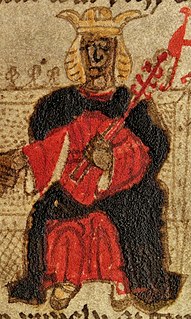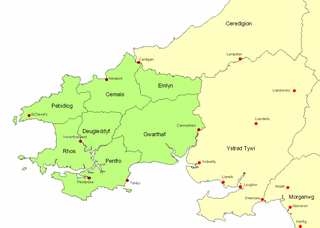Related Research Articles
Owain ap Gruffudd was King of Gwynedd, North Wales, from 1137 until his death in 1170, succeeding his father Gruffudd ap Cynan. He was called Owain the Great and the first to be styled "Prince of Wales". He is considered to be the most successful of all the North Welsh princes prior to his grandson, Llywelyn the Great. He became known as Owain Gwynedd to distinguish him from the contemporary king of Powys Wenwynwyn, Owain ap Gruffydd ap Maredudd, who became known as Owain Cyfeiliog.
Maelgwn Gwynedd was king of Gwynedd during the early 6th century. Surviving records suggest he held a pre-eminent position among the Brythonic kings in Wales and their allies in the "Old North" along the Scottish coast. Maelgwn was a generous supporter of Christianity, funding the foundation of churches throughout Wales and even far beyond the bounds of his own kingdom. Nonetheless, his principal legacy today is the scathing account of his behavior recorded in De excidio et conquestu Britanniae by Gildas, who considered Maelgwn a usurper and reprobate. The son of Cadwallon Lawhir and great grandson of Cunedda, Maelgwn was buried on Ynys Seiriol, off the eastern tip of Anglesey, having died of the "yellow plague"; quite probably the arrival of Justinian's Plague in Britain.

The Kingdom of Gwynedd was a Welsh kingdom and a Roman Empire successor state that emerged in sub-Roman Britain in the 5th century during the Anglo-Saxon settlement of Britain.

Cunedda ap Edern, also called Cunedda Wledig, was an important early Welsh leader, and the progenitor of the royal dynasty of Gwynedd.

Vortiporius or Vortipor was a king of Dyfed in the early to mid-6th century. He ruled over an area approximately corresponding to modern Pembrokeshire, Wales. Records from this era are scant, and virtually nothing is known of him or his kingdom. The only contemporary information about Vortiporius comes from the Welsh ecclesiastic Gildas, in a highly allegorical condemnation from his De Excidio et Conquestu Britanniae. At the time the work was written, Gildas says that Vortiporius was king of Dyfed, that he was grey with age, that his wife had died, and that he had at least one daughter.
Rhun ap Maelgwn Gwynedd, also known as Rhun Hir ap Maelgwn Gwynedd, sometimes spelt as 'Rhûn', was King of Gwynedd. He came to the throne on the death of his father, King Maelgwn Gwynedd. There are no historical records of his reign in this early age. A story preserved in both the Venedotian Code and an elegy by Taliesin says that he waged a war against Rhydderch Hael of Alt Clut and the kings of Gododdin or Manaw Gododdin. The small scattered settlement of Caerhun in the Conwy valley is said to be named for him, though without strong authority. Rhun also appears in several medieval literary stories, as well as in the Welsh Triads. His wife was Perwyr ferch Rhûn "Ryfeddfawr" and their son was Beli ap Rhun "Hîr".
Einion ap Cunedda, also known as Einion Yrth, was a king of Gwynedd. He is claimed as an ancestor of the later rulers of North Wales.
Cadwallon ap Einion, usually known as Cadwallon Lawhir and also called Cadwallon I by some historians, was a Welsh ruler around 500.
The Castle of Dinerth is a Welsh castle located near Aberarth, Ceredigion, west Wales that was completed c. AD 1110. It is also known as Hero Castle, presumably from the Norse hiro.
Owain Danwyn was a king of Rhos in Gwynedd, Wales, in the mid-5th century. He was the son of Einion Yrth and the father of Cynlas Goch, probably the Cuneglasus excoriated by Gildas. Very little is known of his life. Graham Phillips and Martin Keatman proposed a theory that he was the historical figure behind the legend of King Arthur.
Rhos means 'moor' or 'moorland' in Welsh. It is a region to the east of the River Conwy in north Wales. It started as a minor kingdom then became a medieval cantref, and was usually part of the Kingdom of Gwynedd.

Maelienydd, sometimes spelt Maeliennydd, was a cantref and lordship in east central Wales covering the area from the River Teme to Radnor Forest and the area around Llandrindod Wells. The area, which is mainly upland, is now in Powys. During the Middle Ages it was part of the region known as Rhwng Gwy a Hafren and its administrative centre was at Cefnllys Castle.
De Excidio et Conquestu Britanniae is a work written in Latin by the 6th-century AD British cleric St Gildas. It is a sermon in three parts condemning the acts of Gildas' contemporaries, both secular and religious, whom he blames for the dire state of affairs in sub-Roman Britain. It is one of the most important sources for the history of Britain in the 5th and 6th centuries, as it is the only significant source for the period written by a near contemporary of the people and events described.
Cadwallon ap Madog was the son of Madog ab Idnerth who had died in 1140, while Idnerth was a grandson of Elystan Glodrydd who had died in around 1010 and had founded a dynasty in the Middle Marches of Wales, in the area known as Rhwng Gwy a Hafren.
Einion, the Welsh form of the Latin Ennianus, is a male Welsh given name and may refer to:

Saint Cwyllog was a Christian holy woman who was active in Anglesey, Wales, in the early 6th century. The daughter, sister and niece of saints, she is said to have founded St Cwyllog's Church, Llangwyllog, in the middle of Anglesey, where a church is still dedicated to her.

Saint Einion Frenin was a late 5th- and early 6th-century Welsh confessor and saint of the Celtic Church. His feast day was originally given as 9 February, although this had moved to the 10th or 12th by the 16th century and is no longer observed by either the Anglican or Catholic church in Wales.
Cadwallon ap Gruffydd was the eldest son of Gruffudd ap Cynan, king of Gwynedd.
References
- ↑ Latin: ...urse multorum sessor aurigaque currus receptaculi ursi...
- ↑ Latin: ...Cuneglase Romana lingua lanio fulve...
- 1 2 Korrel, Peter (1984). "Arthur, Modred, and Guinevere in the Historical Records and in the Legendary Arthurian Material in the Early Welsh Tradition". An Arthurian Triangle: A Study of the Origin, Development, and Characterization of Arthur, Guinever, and Modred. Leiden: E.J. Brill. p. 8, n. 10. ISBN 9004072721.
- 1 2 Anderson, Alan Orr (October 1912). Watson, Mrs W.J. (ed.). "Gildas and Arthur". The Celtic Review. Edinburgh: T. & A. Constable for William Hodge & Co. (published 1913). VIII (May 1912 – May 1913): 149–165.
- 1 2 3 4 5 6 Bartrum, Peter (1993). "Cynlas Goch ab Owain Danwyn". A Welsh Classical Dictionary: People in History and Legend up to about A.D. 1000 (PDF). National Library of Wales. p. 205. ISBN 0907158730. Archived from the original (pdf) on 17 March 2016. Retrieved 11 December 2017.
- ↑ "Welsh fort identified as citadel of Dark Age king". British Archaeology, no 29. Council for British Archaeology. November 1997. Archived from the original on 9 January 2015. Retrieved 31 December 2012.
- ↑ Bartrum, Peter (1993). "Owain Danwyn ab Einion Yrth". A Welsh Classical Dictionary: People in History and Legend up to about A.D. 1000 (pdf). National Library of Wales. p. 594. ISBN 0907158730.
- ↑ Bartrum, Peter (1993). "Cadwallon Lawhir ap Einion Yrth". A Welsh Classical Dictionary: People in History and Legend up to about A.D. 1000 (pdf). National Library of Wales. p. 94. ISBN 0907158730.
- ↑ Bartrum, Peter (1993). "Maelgwn Gwynedd". A Welsh Classical Dictionary: People in History and Legend up to about A.D. 1000 (pdf). National Library of Wales. p. 500. ISBN 0907158730.